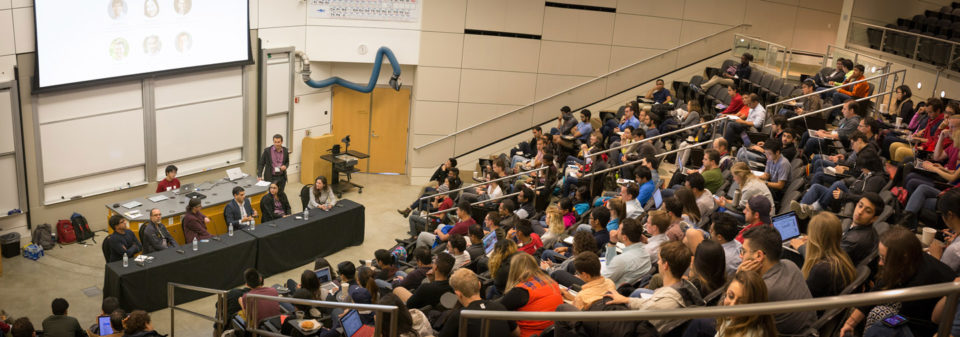Stanford’s first health++ Hackathon brings health care innovators together
Students, health care professionals and entrepreneurs team up at the inaugural health++ Hackathon to create new technologies and lasting collaborations.
Stanford students, faculty and health professionals, as well as designers and entrepreneurs from across the United States, teamed up for a weekend of health care innovation at the inaugural health++ Hackathon.
Participants pitched their projects, formed teams and went from idea to prototype in 36 hours. The goal: create a design, app or business plan that improves health care affordability and access.
Health care systems can be slow to embrace new technologies, said Clinical Associate Professor of surgery Oliver Aalami, who was a faculty adviser for the event. Aalami said many doctors already rely on smartphones for sharing diagnoses and prescribing advice, making that a good platform for innovations.
Aalami added that while a number of health care technology projects have formed at Stanford, the interdisciplinary connection to bring them to fruition has been lacking. “The left arm doesn’t know what the right arm is doing,” he said.
Interdisciplinary teamwork
Of the 257 health++ participants, about half were Stanford undergrads and a quarter were Stanford medical doctors, business students and graduate students. The rest were designers, engineers and entrepreneurs from other institutions and private companies.

Participants in Stanford’s health app hackathon present their prototypes and business models to judges during the project expo. (Image credit: Rachel Leslie)
“It’s incredible to see the energy and interest not just from the engineering school – traditionally I think hackathons appeal the most to engineering students – but the design school and business school have been super-excited as well,” said Sherman Leung, a Stanford computer science major who helped organize the event. “It’s the first time in my Stanford career that I’ve seen something so interdisciplinary.”
The event’s co-founders were undergraduates Jason Wang and Shivaal Roy, who are also current co-presidents of the Stanford student group Stanford Healthcare Innovations in Future Technologies, or SHIFT, which teamed up with undergraduates, medical students and physician advisers to make health++ happen.
“We have such a perfect ecosystem with the hospital, the graduate schools, the undergraduate school,” Aalami said. “It’s just a perfect ecosystem to have amazing things happen.”
Winning projects
A novel pill bottle sticker that makes prescription labels more accessible to people with visual impairments, called Pharmassist, won the grand prize at the event. When placed on a smartphone, the sticker’s unique pattern would enable the phone to read aloud the prescribing information, track the number of pills left and help order a refill.
“By getting together at the Hackathon with a team of five people, it was so awesome that we could build a working prototype in 36 hours,” said Pharmassist lead team member Zahoor Zafrulla.
Zafrulla said he would have needed a week to 10 days to complete the project on his own. As a full-time engineer, he said, this was not possible. Zafrulla’s team included experts in biomedical engineering, biology and computer science. Rohan Roy Choudhury built the Android app that recognized the unique patterns and Kelvin Cho and Heidi Huang created a business plan and presentation, while Zafrulla and another team member, Eric Schade, built the prototype pill bottles.
“They’re coming to the event with very deep experience and an understanding of what the problem is, and basically saying, ‘OK, let’s spend two days and see how we can prototype something to address this problem,’” said Leung.
The other grand prize winners were Foot++, a muscle stimulator for people with foot drop, and Benjamin, an app that informs users of lower-cost options for prescription drugs and insurance plans. A total of 12 teams won prizes. In addition to the overall winners, sponsors of the event selected winners. A total of $7,500 was awarded.
The prizes were awarded based on problem-solving potential and feasibility to implement. The goal was not to create a finished product, which is hard to do in a mere 36 hours. Instead, the biggest impact of bringing together clinicians, business experts and engineers for the weekend was to create a starting point for future innovation.
“We hope that Hackathon can serve as a launching pad, sparking future collaborations and getting people from all departments thinking about health care innovation,” Wang said.
Health++ organizers are already looking forward to next year. Aalami said that Stanford Hospital plans to contribute unidentified medical records next year, which could be used by hackers in big data projects.
The event organizers are excited about the potential for the event to initiate an interdisciplinary community of collaborators on health care issues.
“A ton of problems in health care require interdisciplinary thinking,” Roy said. “We hope health++ can help facilitate that paradigm shift.”
Other advisers for the event were Robert Chang, assistant professor of ophthalmology; Ami Bhatt, assistant professor of medicine (hematology) and of genetics; and Marta Zanchi, biodesign faculty.

